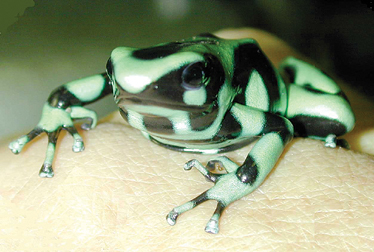Frog chemist creates a deadlier poison
A poisonous frog takes up a toxin from its food and makes the chemical even more potent.
By Emily Sohn
Talk about playing with your food.
Scientists have discovered a poisonous frog that takes up a toxin from its food. It then uses it to make the chemical even deadlier. It’s the first example of a frog using chemistry to make a poison for its own defense stronger.
 |
|
This 4-centimeter-long green poison dart frog, Dendrobates auratus, can increase the power of a particular toxin that it picks up from its food.
|
| Proceedings of the National Academy of Sciences, National Aquarium in Baltimore |
Several types of frogs from South America, Australia,and Madagascar carry deadly poisons in their skin. When raised in zoos and aquariums, however, most of them become totally harmless.
About 10 years ago, researchers from the National Institute of Diabetes and Digestive and Kidney Diseases in Bethesda, Md., figured out that many poison dart frogs take up toxins from the food. Their dining habits include downing ants and other insects. If such prey isn’t available, the frogs got no toxins to store in their skins.
More recently, scientists were working with a toxin called pumiliotoxin 251D. It is often found on the skin of the tropical frog known as the green poison dart frog (Dendrobates auratus). The scientists sprinkled the toxin onto termites and fruit flies. Then they fed these bugs to captive frogs.
Later analyses of the frogs’ skins showed that about 80 percent of the pumiliotoxin 251D had been converted to a different toxin/ It’s known as allopumiliotoxin 267A. The new toxin was five times more toxic to mice than the original poison.
Scientists were surprised. Any creature that tries to eat a wild Dendrobates would get an even bigger surprise. It’s quite possible that its frog-leg dinner would be its last!







